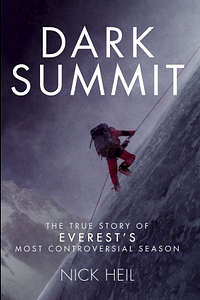Dark Summit, The True Story of Everest's Most Controversial Season
| Page Type | Gear Review |
|---|---|
| Object Title | Dark Summit, The True Story of Everest's Most Controversial Season |
| Manufacturer | Nick Heil (Henry Holt and Company) |
| Page By | silversummit |
| Page Type | Apr 20, 2009 / Apr 20, 2009 |
| Object ID | 6065 |
| Hits | 3988 |
| Vote |
BOOK SUMMARY
From the book cover: "On May 15, 2006, a young British climber named David Sharp lay dying near the top of Mount Everest while forty other climbers walked past him on their way to the summit. A week later, Lincoln Hall, a seasoned Australian climber, was left for dead near the same spot. Hall's death was reported around the world, but the next day he was found alive after spending the night on the upper mountain with no food and no shelter.If David Sharp's death was shocking, it was hardly singular; despite unusually good weather, ten others died attempting to reach the summit that year. In this meticulous inquiry into what went wrong, Nick Heil tells the full story of the deadliest year on Everest since the infamous season of 1996. He introduces Russell Brice, the commercial operator who has done more than anyone to provide access to the summit via the mountain's north side-and who some believe was partly accountable for Sharp's death. As more climbers attempt the summit each year, Heil shows how increasingly risky expeditions and unscrupulous outfitters threaten to turn Everest into a deadly circus."
PRODUCT DETAILS
Price: $26.00Hardbound: 270 pages with color photographs
Author: Nick Heil
Publisher: Henry Holt and Company
Year Published: 2008
Language: English
ISBN: 0-8050-8310-3



silversummit - Apr 20, 2009 9:52 pm - Voted 5/5
A must read for Everest fansIt is almost impossible to read the sections about Sharp and Hall without remembering the 1996 season's tragedies and wanting to blame someone, anyone. Yet, Heil manages to explain why climbers didn't stop and help Sharp.
The saddest part of the entire book is realizing that nothing has really changed since 1996. Even though these climbers were on the north side of Everest with fewer total climbers than on the Nepalese or south side, the risks were just as dangerous. No towering, falling ice seracs but still a season as deadly as one 10 years earlier.